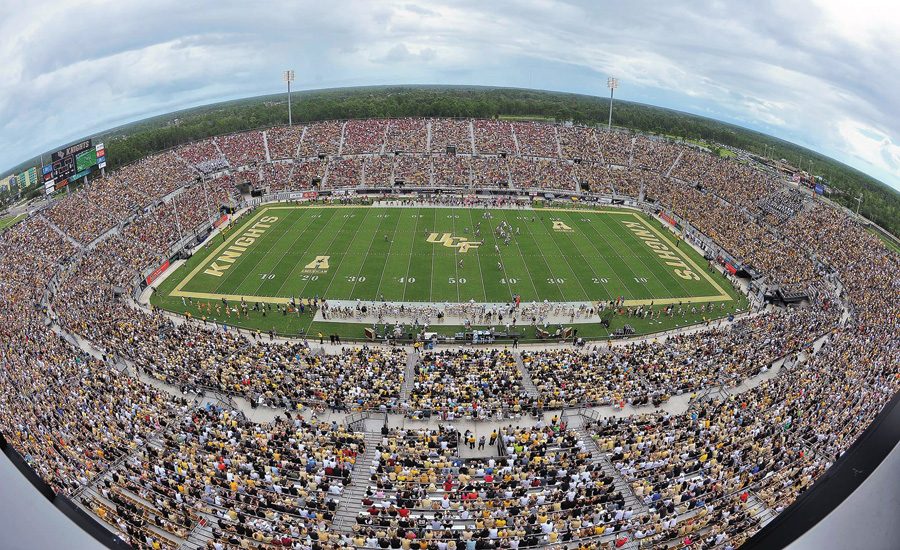Building a Permanent Emergency Operations Center at UCF



Tens of thousands of students and spectators flock to the Bright House Networks Stadium (often called the “Bounce House” when students jump up and down during the game, shaking the stadium) for UCF Knights football games. A short distance away, university and community stakeholders are carefully monitoring social media, weather and security in the university’s permanent EOC.
Photo courtesy of the University of Central Florida



More than 30,000 people regularly attend a University of Central Florida (UCF) Knights football game at the Bright House Networks Stadium in Orlando. As students jump up and down to cheer for their team, a little over a mile away, in a secure building next to the UCF Police Department, a group of university and community leaders waits at the ready, monitoring social media, weather and security systems in the university’s emergency operations center, or EOC.
The university used to have an emergency operations center that could be convened in an empty conference room. The “cold site” had to be quickly furnished with phones, computers and other infrastructure when an incident occurred, taking up to an hour before the EOC could be fully operational.
So when the university’s police department received funding for a new building, the department of emergency management jumped on the opportunity to claim the former law enforcement building as the permanent home of an incident command center that could be fully activated in just five minutes.
According to Jeff Morgan, Director of the Department of Security and Emergency Management, the UCF EOC operates as a hybrid incident command center with emergency support functions. Each seat in the EOC has three personnel assigned to it and trained through FEMA and/or DHS protocols to take over functions there at any time. EOC personnel are designated “critical personnel” by the university, and they ride out hurricanes and other incidents on campus.
The need to keep the EOC operational even during severe weather called for multiple redundancies, Morgan says. In addition to multiple layers of staff, the EOC building has a 72-hour generator and two phone systems, in case one gets knocked offline. A FEMA-certified instructor within the EOC hosts many training and education courses for students, staff and community stakeholders. Past training courses have included hurricane awareness and safety, health and safety planning for students and staff returning from Ebola-stricken regions, and sporting event monitoring and security.
The EOC also hosts both tabletop exercises and functional drills, when interns in the “simulation cell” call different desks at the EOC with changes to the scenario and “outside” information.
When it comes down to real-life incidents, Morgan says he wants all available staff to be as prepared as possible, whether the EOC is in monitoring mode (such as during weather threats) or full activation (such as during a football game or political rally).
For an average football game, a host of stakeholders gets involved in planning and preparing for every eventuality. Within the university, representatives from parking, athletics, media coordination and the police department will be present in the EOC, and external stakeholders such as Orange County Fire and Rescue and the Central Florida Intelligence Exchange (CFIX) will be present or involved. The EOC is monitoring local law enforcement radios and hospital conditions, and the National Weather Service is being carefully watched for news of nearby lightning strikes or other potentially hazardous conditions.
“We’re working to take proactive measures to ensure the safety of everyone at our games and on our campus. That’s the purpose of the EOC,” says Morgan.
“If a worst case scenario happens during a football game, the EOC is up and ready to go,” he adds. The emergency operations department has also invested in infrastructure and technology to help them stay proactive in their efforts. One major step was the university’s creation of an office of security management in December 2014, and placing it under the emergency management umbrella.
According to Joe Souza, CPP, PSP, CBCP, Assistant Director of Security Management for UCF, the security department manages more than 2,000 surveillance cameras and upwards of 1,300 access control card readers, in addition to the university’s security officer force. Keeping this technology’s management within the EOC keeps operators prepared and alert, with the ability to access security systems to track and detect threats before they occur.
Last year, for example, 41 video surveillance cameras were installed inside UCF’s CFE Arena, which hosts basketball and volleyball games, as well as graduations, commencements, concerts and political events, such as a recent Donald Trump speech and rally. This new installation gives security and emergency operations personnel eyes on the seating bowl, back hallways and the venue part of the arena, even if sections are curtained off for different events. Using six cameras from Axis Communications, security personnel in the EOC can see 20 degrees above the horizon, which enables them to monitor every seat in the arena as well as the rafters and catwalks high above the arena floor.
By working with digital pan-tilt-zoom features, “if we see something suspicious, we can detect it without missing something else,” says Souza. In addition, he says, if there’s an incident during an event, operators in the EOC can provide additional intelligence to security or law enforcement teams on the ground, all while protecting the university.
“For example, during the recent Trump rally, as people were ejected from the rally, EOC personnel could pull up surveillance cameras to monitor security officers’ progress as they escort protesters from the event, to protect the university, to protect the people being escorted out, and to protect the security officers,” he says. “If something happened, we would capture it (on video) and be able to say ‘This is what really happened.’ In the past, we weren’t always able to do that. The grant funds that we received from the Department of Homeland Security gave us this better capability, which makes it a lot easier for us to keep our community safe at the end of the day.”
The university’s EOC is also working on outfitting a box truck as a mobile wireless mesh surveillance platform, with four mobile cameras and one on the truck. This will enable the university to better monitor flexible or infrequent events, such as tailgating, the annual “Spirit Splash” (when students jump into one of the large fountains on campus), or a political protest.
The EOC uses Snaptrends social media monitoring tools to stay aware of suspicious chatter during events and to determine when additional information or guidance is needed. For example, if an operator determines that a group of students is planning to rush the football field if UCF wins, the university’s social media team could send out a message discouraging that behavior, or warning of repercussions or dangers of hopping over the wall onto the field.
A new system the university is utilizing is called Mutualink, which enables personnel in the EOC to share images on their screens – such as floor plans, video, documents and more – with first responders, local hospitals, or other partners to help keep the region informed. The system also enables the EOC to patch the public safety radio channel used by campus law enforcement and the security department’s channel together to enable more seamless communication during an event. If UCF Police Chief Richard Beary is out of town at a conference or speaking in Washington, DC, the system can patch his mobile phone into the radio system as well.
The security and emergency management department also works closely wi th UCF’s IT department to evaluate new security technology and develop an “approved products list” for future projects. This way, when funds become available, Souza and Morgan already know which security solutions are robust and compatible with the university’s infrastructure.
“It’s a good marriage between emergency management and security at UCF,” says Morgan. “We have access to more than 2,000 cameras; we can monitor access to doors, so during a football game, if there are people inside an area they’re not supposed to be in, we can send security out there to ask them to leave. We also watch the status of our doors and can lock down for special events. We share all that information with our police dispatch. It’s a force multiplier for the university, using technology between security management, emergency management and the police department.”
The UCF security team also found a lot of value in attending last year’s ASIS International Seminars and Conference in Anaheim, California. What the team had envisioned – upgrading the video management system, consolidating the number of products in use, researching new products and looking at the latest technology – the show enabled Morgan and Souza to do so all at once. “It helps us strengthen everything we’re doing and validate that we’re working with the right partners, the right products and technology, and ensuring that we’re putting the latest in place in UCF as we go forward,” says Souza.
As a whole, UCF’s campuses gain peace of mind and constant support through the formulation of the permanent EOC.
According to Morgan, “When we find out that Trump is coming to campus, or the new football coach wants to have a spring football game to try something different, we can bring all our stakeholders into one place to formulate a plan, fallbacks and redundancies. The EOC enables us to make decisions face to face, which makes us better prepared on how we want to cover these major events.”
Upgrading to IP at Safeco Field
Safeco Field, the Pacific Northwest’s only Major League Baseball stadium and home of the Seattle Mariners, needed a surveillance upgrade. When the stadium was built in 1999, it had a system of 114 analog cameras connected throughout the stadium via cable. However, adding additional cameras or updating facets of the surveillance system moving forward was cost-prohibitive and would require significant re-wiring.
Working with integrator Differential Networks, the stadium undertook an IP networked surveillance upgrade in 2013, and now, all of the stadium’s 222 cameras are connected and controlled over the network for higher quality video. Cameras are updated with IP and megapixel cameras as needed, and the remaining analog cameras are digitized through video encoders while the system is upgraded. The surveillance system is managed through a Milestone VMS that enables operators in the stadium’s 24/7/365 control room to save video footage of incidents on USB drives or DVDs for law enforcement, monitor line length at entrances, and verify alarms.
Instead of analog pan-tilt-zoom cameras, Christopher Ellis, Director of Safety and Security for the Seattle Mariners, is impressed with the digital zoom qualities of his current Sony IP surveillance cameras, which reduces the risk of missing an incident or detail while an operator moves the camera to follow a potential suspect.
The system has been a good investment for the ballpark from both security and operational standpoints, Ellis says. Security operators cannot watch hundreds of cameras at the same time, he adds, so they can use alarms and related video to catch incidents.
For ballpark operations, the surveillance system is used to watch entrance gates to check the length of security lines and monitor for incidents.
This enables security to verify whether a broken smartphone during a screening was the fault of the visitor or the ballpark staff. Operators can also use the cameras to help media relations address concerns or claims on social media about wait times at ballpark entrances or screening requirements, Ellis says.
Looking for a reprint of this article?
From high-res PDFs to custom plaques, order your copy today!








